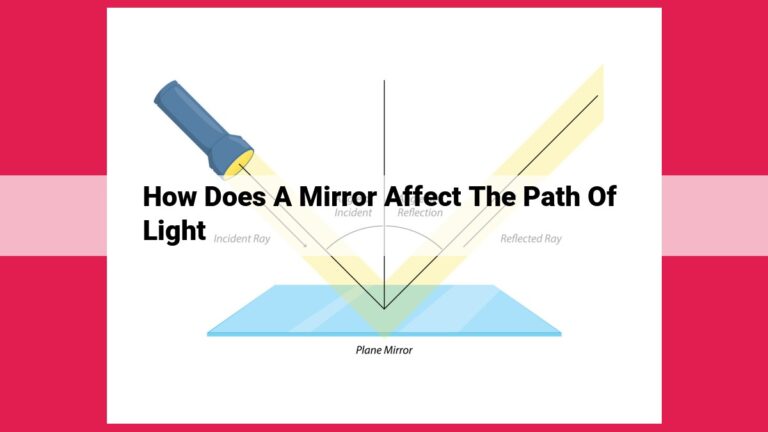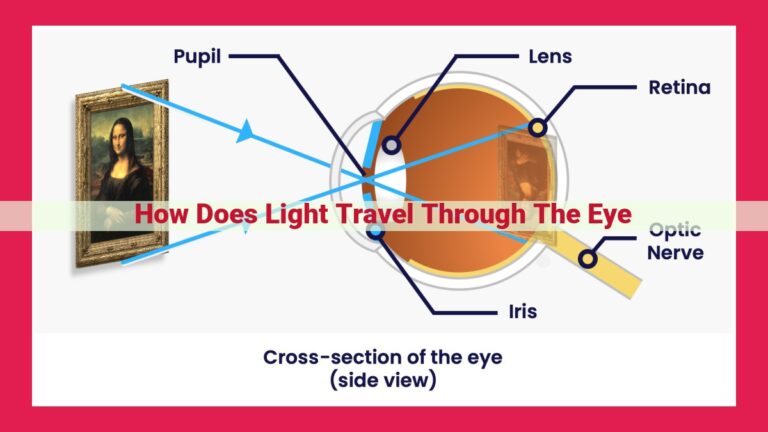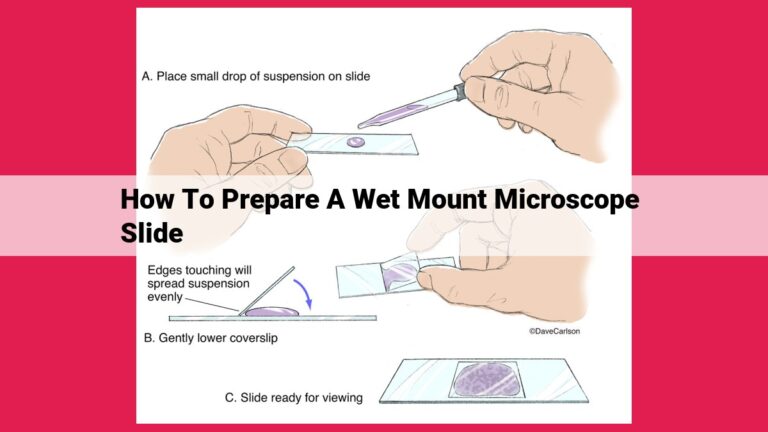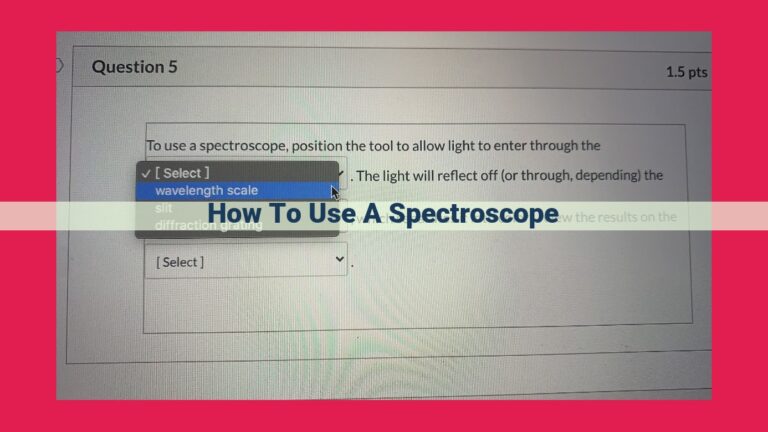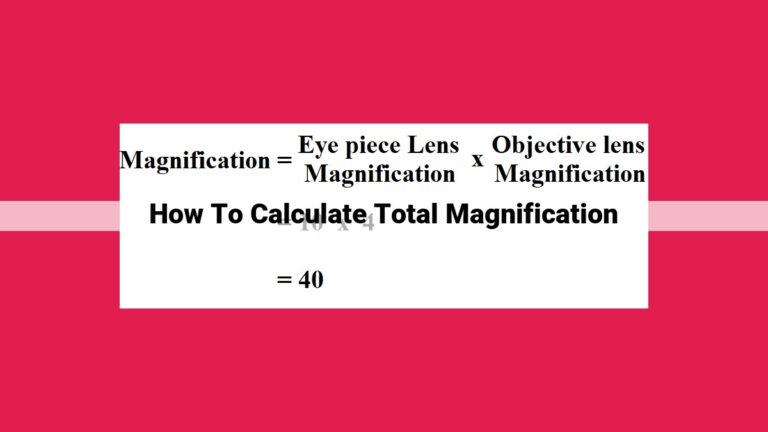Calculating Total Magnification In Microscopy: A Comprehensive Guide
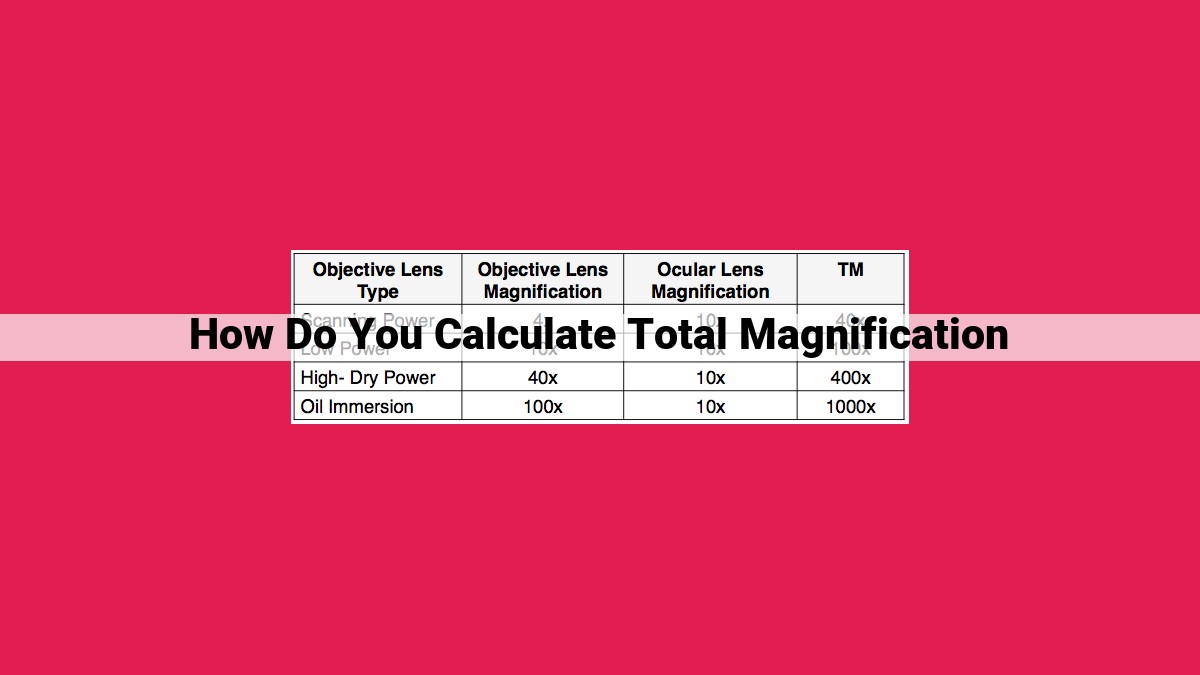
Total magnification (Mt) in microscopy is calculated by multiplying the eyepiece magnification (Em) by the objective lens magnification (Om). Eyepiece magnification magnifies the virtual image formed by the objective lens, while objective lens magnification captures the object’s details. Total magnification influences image size but affects resolution, so an optimal balance must be found. To calculate Mt, identify the magnification values on lens barrels and multiply them together (Mt = Em x Om). Understanding total magnification is crucial for accurate observations and analysis in microscopy.
Magnification: Unlocking the Microscopic World
Magnification: The Art of Enlarging Images
In the realm of microscopy, magnification holds paramount importance. It empowers us to transcend the limitations of our naked eyes, unveiling the intricacies of microscopic worlds that would otherwise remain hidden. Magnification, in essence, is the process of enlarging an image, revealing details that are too small to be perceived without the aid of optical instruments.
The Microscope: A Window into the Unseen
Microscopes, with their ingenious combination of lenses, serve as our gateway to the microscopic domain. Lenses, with their ability to bend light, allow us to manipulate images, bringing distant objects closer or making tiny objects appear larger. In a microscope, the objective lens, positioned closest to the specimen, captures light from the sample and projects an enlarged image onto the eyepiece.
The eyepiece, located at the other end of the microscope, plays a crucial role in further magnifying the image projected by the objective lens. It creates a virtual image that appears to float in space, providing a magnified view of the specimen.
Eyepiece Magnification (Em): Unveiling the Virtual World
In the realm of microscopy, the eyepiece plays a pivotal role in presenting an enlarged and virtual image of the specimen. It acts as a magnifying glass, transforming the tiny details of the microscopic world into a visible realm for our eyes.
The focal length of the eyepiece, measured in millimeters (mm), determines the magnification power. A shorter focal length eyepiece produces a higher magnification, allowing us to see smaller structures in greater detail.
To delve deeper into this concept, imagine the eyepiece as a miniature telescope. It consists of two lenses: an objective lens that focuses light rays from the specimen and a field lens that magnifies the image created by the objective lens.
The virtual image formed by the eyepiece appears at a distance from the lens known as the virtual image distance. This distance determines the apparent size of the image and is directly proportional to the focal length. A shorter focal length results in a closer virtual image distance, making the image appear larger.
The eyepiece magnification (Em) is calculated using the formula: Em = 250 mm / Focal length of the eyepiece. For instance, an eyepiece with a focal length of 10 mm would have an eyepiece magnification of 250 mm / 10 mm = 25x.
Understanding eyepiece magnification is crucial for selecting the appropriate eyepiece for your microscope. It allows you to tailor the magnification to the desired level of detail and size of the observed image.
Objective Lens Magnification: Illuminating the Specimen’s Secrets
In the realm of microscopy, the objective lens plays a crucial role in capturing light from the specimen, allowing us to delve into the intricate details of the microscopic world. Its magnification power, determined by its design, is a key factor that determines the overall resolution and clarity of the observed image.
Lens Design and Magnification
Objective lenses are designed with various focal lengths, which directly impact their magnification. A shorter focal length lens has higher magnification, allowing for a closer view of the specimen. Conversely, a longer focal length lens has lower magnification, providing a wider field of view.
The magnification of an objective lens is typically engraved on its barrel, expressed in multiples of the standard unit of magnification known as the “x” symbol. For instance, an “x10” objective lens magnifies the image by a factor of ten.
Types of Objective Lenses
Microscopes typically utilize multiple objective lenses with different magnifications to provide a range of viewing options. These lenses are commonly classified into three categories:
- Low-power objectives (x4-x10): Provide a wide field of view, suitable for initial examination and orientation.
- Medium-power objectives (x20-x40): Offer intermediate magnification, allowing for detailed observation of larger structures.
- High-power objectives (x50-x100): Provide the highest magnification, enabling the visualization of fine structures and organelles.
Magnification and Resolution
While magnification is essential for enlarging the image, it should be noted that there is a trade-off between magnification and resolution. Higher magnification can magnify the image, but it may also reduce the resolution, making fine details appear blurry.
Therefore, it is important to select the appropriate objective lens based on the desired level of detail and the size of the specimen being observed. For instance, if examining a large tissue sample, a low-power objective with a wide field of view would be suitable. Conversely, for studying small subcellular structures, a high-power objective with high magnification would be necessary.
By understanding the function and design of objective lenses, microscopists can optimize their observations, ensuring they capture the optimal level of detail for their research or diagnostic purposes.
Total Magnification: Combining Eyepiece and Objective Lens
In microscopy, achieving the desired level of magnification is crucial for capturing intricate details of specimens. Total magnification, denoted as Mt, represents the combined effect of eyepiece magnification (Em) and objective lens magnification (Om). This blog post will delve into the concept of total magnification, its formula, and its impact on image size and resolution in microscopy.
Defining Total Magnification
Total magnification, in essence, is the overall enlargement factor of an image obtained through a microscope. It is calculated by multiplying the magnification of the eyepiece by the magnification of the objective lens used.
Formula for Calculating Total Magnification:
Mt = Em x Om
where:
- Mt is total magnification
- Em is eyepiece magnification
- Om is objective lens magnification
Understanding the Formula
The formula for total magnification highlights the collaborative nature of the microscope’s components. The eyepiece, located at the top of the microscope, creates a virtual image of the specimen. The objective lens, positioned closer to the specimen, captures light from the specimen and forms an enlarged, real image. The combined magnification of both lenses determines the final size of the observed image.
Impact of Total Magnification
Total magnification has a profound impact on the size and detail of the observed image.
- Image Size: Higher total magnification results in a larger image of the specimen, allowing for the examination of smaller details.
- Resolution: However, as magnification increases, the resolution of the image may decrease. Resolution refers to the ability to distinguish between two closely spaced points. Excessive magnification can lead to a loss of resolution, making it challenging to discern fine details.
Choosing the Right Magnification
Selecting the appropriate magnification for a specific observation is essential. With a lower magnification, the overall image size is smaller, but the resolution is higher, permitting the observation of larger specimens or a wider field of view. Conversely, higher magnification affords a larger image but may compromise resolution, limiting the study of minute details. Researchers must carefully balance these factors based on the objectives of their investigation.
Total magnification is a critical aspect of microscopy, allowing researchers to tailor the size and detail of their observations. By understanding the concept of total magnification and its formula, scientists can select the optimal magnification for their specific research needs. This knowledge empowers them to extract meaningful insights from microscopic examinations, unlocking the secrets of the cellular world.
Impact of Total Magnification: Size vs. Detail
As you crank up the total magnification, you’re inflating the size of the image. It’s like zooming in on a photograph, making the subject appear larger than life. However, this pursuit of magnification glory comes with a subtle trade-off.
Beyond a certain threshold, the curse of resolution creeps in. Resolution refers to the microscope’s ability to distinguish tiny details, like the individual bristles on a microbe’s hair. As you push up the magnification, the resolution inevitably plunges.
This phenomenon is akin to trying to read microscopic text with a powerful magnifying glass. While the letters balloon in size, they become blurry and indecipherable. In microscopy, the same principle applies.
Increasing magnification widens the field of view, allowing you to survey a broader landscape. However, it compromises your ability to dissect the finer details. On the flip side, decreasing magnification shrinks the field of view, but enhances the resolution, enabling you to focus on specific features with unprecedented clarity.
Calculating Total Magnification in Microscopy: A Step-by-Step Guide
When peering into the microscopic world, understanding total magnification is crucial for accurate observation and analysis. It’s the key to unlocking the secrets hidden within tiny specimens.
Identify Magnification Values
Before embarking on the calculation, it’s essential to gather the magnification values inscribed on the lens barrels. These numbers represent the eyepiece magnification (Em) and objective lens magnification (Om).
Formula for Total Magnification
Once equipped with these values, we can unravel the total magnification (Mt) using a simple formula: Mt = Em x Om
Step-by-Step Instructions
To illustrate, let’s say we have an eyepiece with an Em of 10x and an objective lens with an Om of 40x. Simply multiply these values: 10x x 40x = 400x
Result
In this example, the total magnification is 400x. This means that the image observed through the microscope is 400 times larger than the actual specimen.
Importance of Magnification
Higher magnification allows us to magnify tiny details, but it comes with a trade-off: it decreases the field of view. This means we can see less of the specimen at once. Therefore, it’s important to choose the appropriate magnification for the desired level of detail and observation area.
Understanding total magnification is a cornerstone of microscopy. By following these simple steps, you can accurately calculate the magnification of your microscope, empowering you to explore the intricate details of the microscopic realm.
